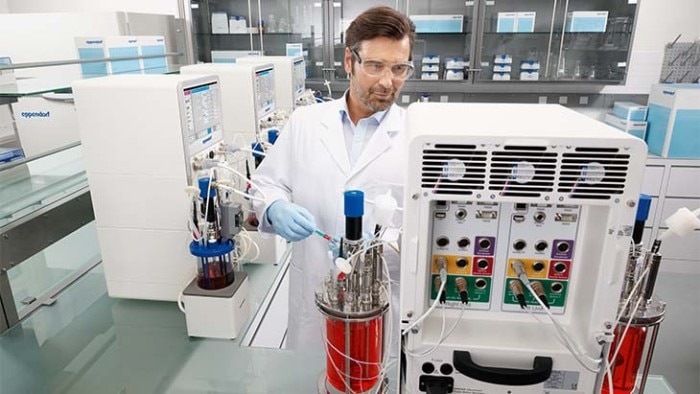-
- Benchtop Centrifuges
- Floor-Standing Centrifuges
- Refrigerated Centrifuges
- Microcentrifuges
- Multipurpose Centrifuges
- High-Speed Centrifuges
- Accessories
- Ultracentrifuges
- Concentrator
- High-Speed and Ultracentrifugation Consumables
- Tubes
- Plates
- Device Management Software
- Sample and Information Management
pH Control in Bioreactors
Read more
Read less
Principle of pH control in bioprocesses
Read more
Read less
What different types of pH sensors are available?
Electrochemical pH sensors
- Advantages: The glass membrane material can be adapted to various bioreactor conditions, including extremes in pH or temperature.
- Disadvantages: Glass pH sensors require careful management and can lose accuracy over time, with a need for frequent calibration.
Read more
Read less
Optical pH sensors
- Advantages:
- Optical pH sensors can be used in a non-invasive manner that reduces the contamination risk. This is particularly interesting for cell culture applications.
- Optical pH sensors are inexpensive and disposable.
- Disadvantages:
- The measurement range of optical pH sensors is narrower than the range of electrochemical pH sensors. Eppendorf recommends a measurement range of pH 6.5 to 7.5. This is usually sufficient for cell culture applications but may be too narrow for certain microbial applications.
- Certain chemicals including organic solvents can damage optical pH sensors. Additionally, these sensors can measure a relatively limited pH range.
Read more
Read less
What are digital pH sensors ?
Read more
Read less
pH control strategies
What acid and base should I use for pH control in microbial and cell cultures?
Read more
Read less
What is a pH deadband?
Read more
Read less
What is the difference between one-sided and two-sided pH control?
Read more
Read less
How do you calibrate a pH sensor?
Electrochemical pH sensor calibration
Read more
Read less
Read more
Read less
Optical pH sensor calibration
Read more
Read less
How frequently should you calibrate pH sensors?
Read more
Read less
How strong is the influence of temperature for your pH calibration?
Read more
Read less
Your pH sensor take ages to calibrate, what can you do?
Read more
Read less
Bioprocess control systems for streamlined pH control in bioreactors
Eppendorf has a range of bioprocess control systems suitable for both microbial and mammalian cell cultures. They offer high flexibility in pH control. Most systems are compatible with standard electrochemical as well as optical pH sensors and can be used with digital as well as analog sensors. Each bioprocess controller also has the ability to control a range of additional parameters such as temperature and dissolved oxygen , enabling streamlined bioprocess control tailored towards your bioprocessing needs.

